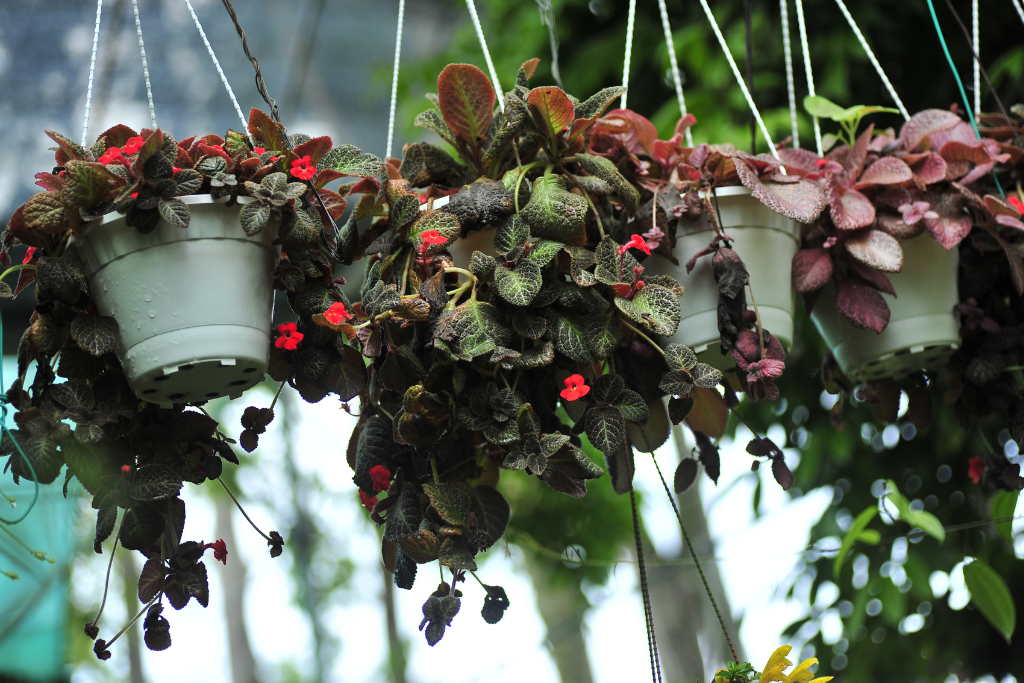
Welcome to the world of the twisted lipstick plant, where beauty meets quirkiness in the most delightful way possible. If you’re tired of the same old boring houseplants, then this special green is here to shake things up. With its unique twisting vines and vibrant red flowers that resemble a tube of lipstick, it’s going to be the perfect addition to your growing selection. Not only will it jazz up your space, but it’s also easy to care for and will thrive in a variety of environments. Get ready to fall in love with this unparalleled beauty!
Interesting Facts About The Twisted Lipstick Plant
The twisted lipstick plant, also known as Aeschynanthus radicans, is a member of the Gesneriaceae family and is native to Southeast Asia. This epiphytic green is found growing in the wild on trees or rocks, often in shaded areas of tropical rainforests. Its scientific name, Aeschynanthus, is derived from the Greek word “aeschyno” which means “to be ashamed,” likely referring to the plant’s small flowers that may seem modest in comparison to the ones of its counterparts in the same family.
In terms of physical appearance, it boasts long, narrow leaves that are a deep, glossy green color. However, its most amusing feature is definitely its bright red, pipe-shaped flowers that bloom in clusters from the stems. This unique charmer usually grows up to several feet in length, making it an aesthetically pleasing trailing plant for both indoor and outdoor settings.
While often kept between four walls, it also tolerates open-air environments in tropical or subtropical regions. Since in its natural habitat, a twisted lipstick plant growing on other flora is not a rare occasion, a hanging basket makes the best residence for it.
Other Names For This Tropical Treasure
- Lipstick vine
- Basket vine
- Tawny-flowered flamevine
- Porcelain flower
- Red-veined pipevine
- Curvy lipstick plant
Twisted Lipstick Plant Care Guide

1. Soil
First and foremost, it’s significant to understand that the twisted lipstick plant is an epiphyte. This means that in nature, it grows on trees and rocks to use them for support, but it doesn’t rely on them for nutrients. As such, it requires a soil mix that is porous, aerated, and holds moisture without becoming soggy.
To achieve this, it’s recommended to use a specifically designed, high-quality potting mix. It should be a combination of organic and inorganic materials, such as peat moss, coconut coir, perlite, and orchid bark. These will provide the necessary structure and drainage for the roots to grow and spread, while also retaining some moisture.
Another essential aspect of the twisted lipstick plant’s soil needs is pH level. This home flora prefers a slightly acidic to neutral pH range of 5.5 to 7.0. So, if your mix falls out of this range, you can always adjust it by adding dolomite lime or sulfur.
Let’s also not forget that this resilient vine is sensitive to salt build-up in the soil. To prevent this, you should water it thoroughly and allow excess water to drain away. Avoid letting the roots sit in standing water to circumvent the possibility of root rot.
2. Watering
As with any plant, proper care is necessary to ensure longevity and vibrancy, and watering is one of the most critical factors in maintaining health.
Like several gesneriads that are native to exotic countries, the twisted lipstick plant also has deep green, waxy foliage and brilliant flowers. These pot-bound beauties require a moderate amount of water to thrive, and their watering requirements can be broken down into several key factors.
Firstly, it’s essential to consider the potting medium. The vine prefers a well-draining mix that doesn’t hold excess moisture. Therefore, it’s essential to choose a high-quality product that allows extra water to escape.
Secondly, the frequency of watering is also crucial. While the plant requires moderate watering, it’s important not to give it too much to drink. Typically, once or twice a week is sufficient, but this can vary depending on factors such as the size of the plant and the pot, and the environment in which it’s growing.
Thirdly, the method of watering is also important. The twisted lipstick plant should be watered at the base, as wetting the leaves might lead to fungal and bacterial growth. It’s also essential to avoid getting water on the leaves to avoid sunburn.
Lastly, monitoring responses to care is also a key point. Flooding the green may bring about leaf discoloration while letting it dry out sooner or later results in wilting. Therefore, observe your pot-dweller regularly and adjust its drinking schedule as needed.
3. Temperature
When it comes to temperature, the twisted lipstick plant has specific needs that must be met for it to thrive. Simply put, it requires warm and humid conditions to develop.
Ideally, it should be kept in a temperature range between 60°F and 80°F (15.5°C to 26.7°C). Too hot or too cold surroundings set the plant up for deterioration.
In addition, the plant also requires a relatively high level of humidity. In its country of origin, this pot-bound beauty would receive moisture from both rain and fog. To replicate these conditions, it is recommended that the vine be placed in a room with a humidifier, or alternatively, misted regularly to maintain the proper water content of the air.
It’s also worth noting that the twisted lipstick plant is sensitive to sudden changes in temperature and humidity. For this reason, it’s best to keep it away from drafty areas, such as open windows or doors, or rooms with air conditioning or heating vents.
4. Lighting
If you’re thinking about bringing one of these beauties into your home, it’s important to understand that in nature, it is accustomed to living in the dappled shade of the forest floor, where it receives filtered light through the canopy above. As a result, this greenery prefers an adequate amount of indirect light. While it tolerates some shade, it doesn’t feel well in complete darkness.
When it comes to indoor lighting, the twisted lipstick plant should be placed near a window that’s covered with a light drape or thin curtains, so it doesn’t overwhelm the foliage with burning sun rays. Why? Well, because otherwise, you’ll notice signs of scorching and damage on the leaves. If you don’t have a window with sufficient light, an artificial light might also do as a supplementary solution.
Be aware that this home flora is sensitive to changes, so avoid moving it around too much once you find a good spot for it. If you need to alter its location, do so gradually over a period of a few days to allow the plant to adjust to the new conditions.
5. Fertilizing
Fertilizers are essential to promote growth and health by providing the necessary nutrients, such as nitrogen, phosphorus, and potassium. These nutrients are typically found in the soil, but over time they can become depleted or unavailable to the plant, which is where fertilizers come in.
As we’ve already discussed, the twisted lipstick plant feels in its element in moist and humid environments. Therefore, it’s essential to use a fertilizer that is specifically formulated for tropical greenery. Look for a product high in nitrogen, as this will promote leafy growth and encourage the production of more flowers.
The ideal fertilizer is diluted in water and applied every three to four weeks during the growing season, which is typically spring and summer. This allows for more efficient absorption of nutrients and prevention of overfertilization.
In addition, take into account the unique needs of this viny climber. Since it thrives in moderately acidic soil pH, make sure to pick a fertilizing product that is formulated for greens with an acidic appetite. Additionally, stay away from solutions that are high in potassium, as this can cause your leafy friend to produce fewer flowers.
When applying the fertilizer, follow the manufacturer’s instructions carefully and avoid getting any of the liquid on the leaves or flowers in order not to cause any damage. Water thoroughly before and after the process to help the nutrients penetrate the soil and reach the roots.
Twisted Lipstick Plant Propagation
- Choose the right time and materials: Propagation is best done in the spring and summer when your home greenery is actively growing. You will need a sharp and clean pair of scissors, a clean container, and some fresh potting mix.
- Select a healthy stalk: Choose a stem with at least two or three nodes, which are the points on the stem where leaves emerge. It should also be about 4-6 inches long.
- Cut the stem: Use the scissors to make a clean cut just below a node. The cutting should be about 4-6 inches long, and make sure to remove any leaves or flowers from the lower part of the stem.
- Prepare the piece: Remove the bottom pair of leaves from the stem, leaving only one or two pieces of foliage at the top. You can also dispose of any flowers or buds to encourage the plant to focus on rooting instead of flowering.
- Dip the cutting in rooting hormone (optional): If you have rooting hormone, dip the bottom of the stem in it before planting. This fosters quicker root formation.
- Plant your new piece: Fill your chosen container with fresh potting soil and use a pencil or similar tool to make a small hole in it. Insert the cutting into the hole and gently pack the mix around it to keep it intact.
- Water the cutting: Lightly watering the soil helps it settle around the cutting. After this step, place the pot in a warm and sunny location with not too heavy sunlight. Keep the soil consistently damp, but not waterlogged.
- Wait for roots to form: After a few weeks, the cutting should begin to develop roots. You can check this by gently tugging on the stem to see if it resists. Once roots have formed, you can gradually reduce the frequency of watering and start fertilizing.
Where to Buy a Twisted Lipstick Plant

While they are not as commonly found as other houseplants like the snake plant, they are still relatively easy to find if you know where to look.
One option for purchasing a twisted lipstick plant is to visit your local nursery or garden center. Many of these stores will carry a variety of indoor greenery and may have your desired green in stock. Another option is to visit a specialty store that focuses on rare and unusual flora. These stores may be more likely to have these plants up for sale, but they may also be more expensive.
If you prefer to shop online, there are a number of retailers that sell basket vine.
When purchasing, it’s crucial to pay attention to getting an undamaged piece. Look for bright green foliage and no signs of wilting or disease. Also, ensure that the plant is appropriate for your level of care experience, as some greens may be more difficult to maintain than others.
Conclusion
The twisted lipstick plant is a unique and charming addition to your apartment, house, or office, that’s sure to stand out in your collection. Not only does it have eye-catching vivid red flowers and twisting vines, but it’s also easy to maintain, making it perfect for both novice and experienced horticulturalists. So, whether you buy it online or at your local nursery, this one-of-a-kind flora is sure to bring joy and personality to any space.



